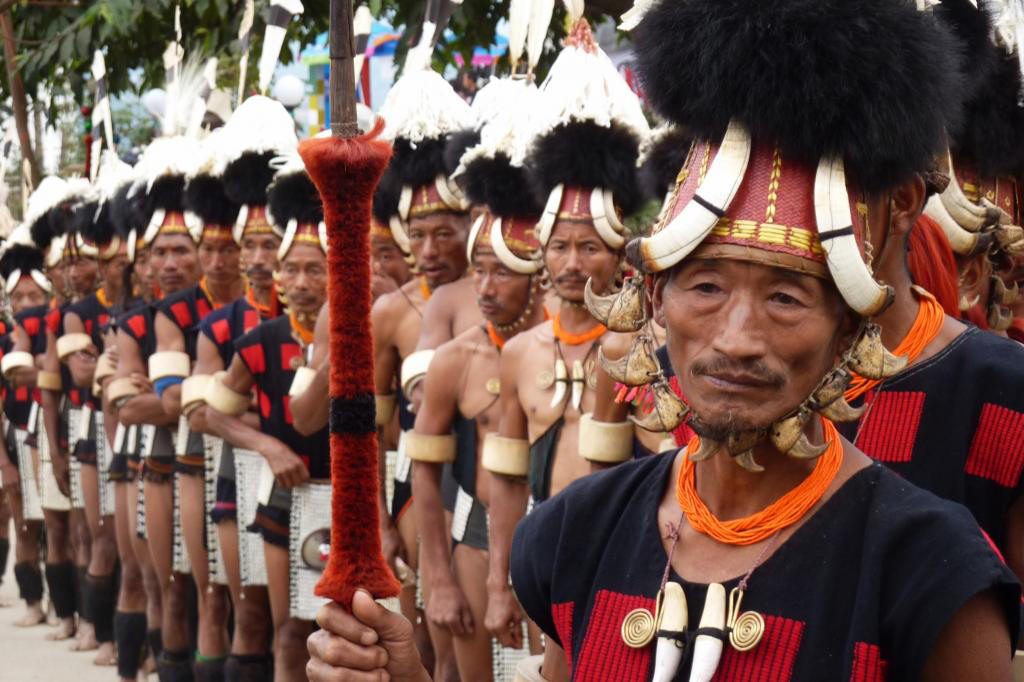
A scenic green environment filled with mountains and valleys, the state of Nagaland is located in the extreme end of North-east India. Nagaland has a total geographical area covering 16,579 sq. km. and a population of around 2 million as per Census of India 2011. The state was formally inducted on 1 December 1963, as the sixteenth state of the Indian Union. It borders the state of Assam to the West, Myanmar (Burma) to the East, Arunachal Pradesh and parts of Assam to the North and Manipur to the South.
The ancient history of Nagaland is rather unclear. Some anthropologists suggest its people belong to the Indo-Mongoloid races, that came in waves from Central Asia towards the end of the B.C era. Whether in historical records or oral traditions passed from one generation to the other, the first mention of the Nagas as a people inhabiting their present lands was made by Claudius Ptolemy, the Greek geographer and historian in AD 150. Eventually, the region came under the occupation of the British in 1826 and its capital city of Kohima witnessed heavy fighting during World War II.
In August 1947, the day before India gained independence from the British rule, the Nagas were the first ethnic group from the North-east to declare their territory as an independent state.
The state of Nagaland is divided into 12 Administrative Districts, in 2004 there were 7 districts but later 5 new districts were carved out of Kohima and Tuensang district. The state capital is Kohima, and the largest city is Dimapur.
Nagaland is home to 16 indigenous tribes along with other sub-tribes, each having its own character in terms of customs and language. Over 89 different languages and dialects are spoken in Nagaland. Each tribe dwelling in these exotic hills can easily be distinguished by their intricate costumes embellished with traditional beads and jewels.
In the days of yore, the traditional attire of each tribe beholded a sight, multicoloured spears decorated with dyed goat’s hair, headgear made of bamboo interlaced with orchid stems, hornbill feathers etc., the warriors had to earn these items through acts of valour in order to wear them.
The tribes have an equalitarian society and people live in traditional villages. Each village is divided into a certain number of clan territories or khels. Each khel has their own “morung” which is a body meant for self-governance.
In Nagaland, music and dance is an essential part of Naga culture. The music of different tribes of the state express their melodious diversity, its traditional folk tales eulogizing ancestors and incidents, the brave deed of traditional heroes; poetic love songs; seasonal songs for particular agricultural cycle; gospel songs or modern tunes inspires cultural heritage of the state while still getting you to tap your feet. War dances and other dance belonging to distinctive tribes are a major art form in the state.
20 percent of the total land area of Nagaland is covered with wooded forest. The evergreen tropical and sub-tropical forests are found in strategic pockets in the state which occupy 8,62,930 hectares of the land. The biodiversity of North-eastern states of India vividly illustrates the diverse natural heritages that the states are blessed with, which are also a treasure trove of a plethora of medicinal plants.
The flora of Nagaland is dominated by the growth of the thick wooden trees like the mahogany and timber as well as bamboo, rattan, palms etc., while some forest areas are cleared for jhum cultivation. Due to its destruction to facilitate jhum cultivation, the wanton destruction is leading to the gradual depletion of the rich biodiversity of the state.
The torrential monsoon rains are an integral feature of the state’s weather, where the state enjoys a salubrious climate. The maximum average temperature in summer is 31 degree Celsius while the minimum is as low as 4 degree Celsius in winter. Some regions in the state are subject to frost in winter. The closeness to the Himalayan foothills and the torrential monsoon rains has resulted in the prosperity of the mighty rivers.
The tributaries of the great Brahmaputra River flow through the Dhansiri river which originates in the mountainous Laisang peak in Nagaland. The other rivers of Nagaland are Dikhu, Doyang and the Jhanji, they are the chief rivers of the state forming huge catchment areas.
Nagaland boasts of rich biodiversity, the Fakim Sanctuary which is close to the Myanmar border is a home to numerous flora and fauna, the Intanki Wildlife Sanctuary situated in Kohima and Dimapur districts abounds in natural vegetation, the chief attraction of the sanctuary is the Hoolock Gibbon which is the only kind of Gibbon found in India.
The Intanki National Park, a wildlife park in Peren district and the Ghosu Bird Sanctuary, located in Zunheboto district host 20 endangered bird species.
Nagaland is also known as the “Falcon capital of the world”, every year from mid-October to mid-November, thousands of falcons gather along the banks of the Doyang river reservoir, which is a spectacle that is impossible to describe in words. This is also probably the largest migration of raptors (of one species) in the world.
Article by Vikunu Khieya. Image by R. Eime via Flickr
